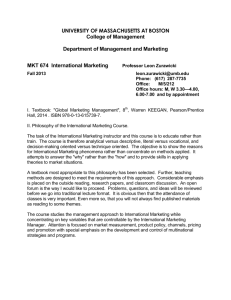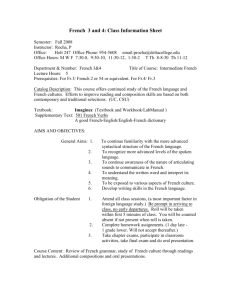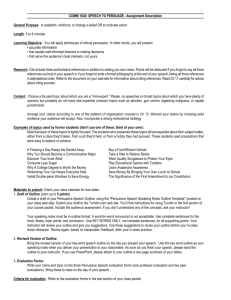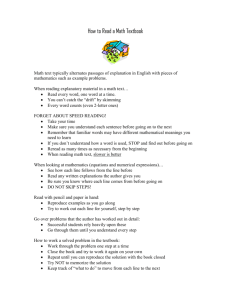MEAPSA 4e Instructor's Guide
advertisement
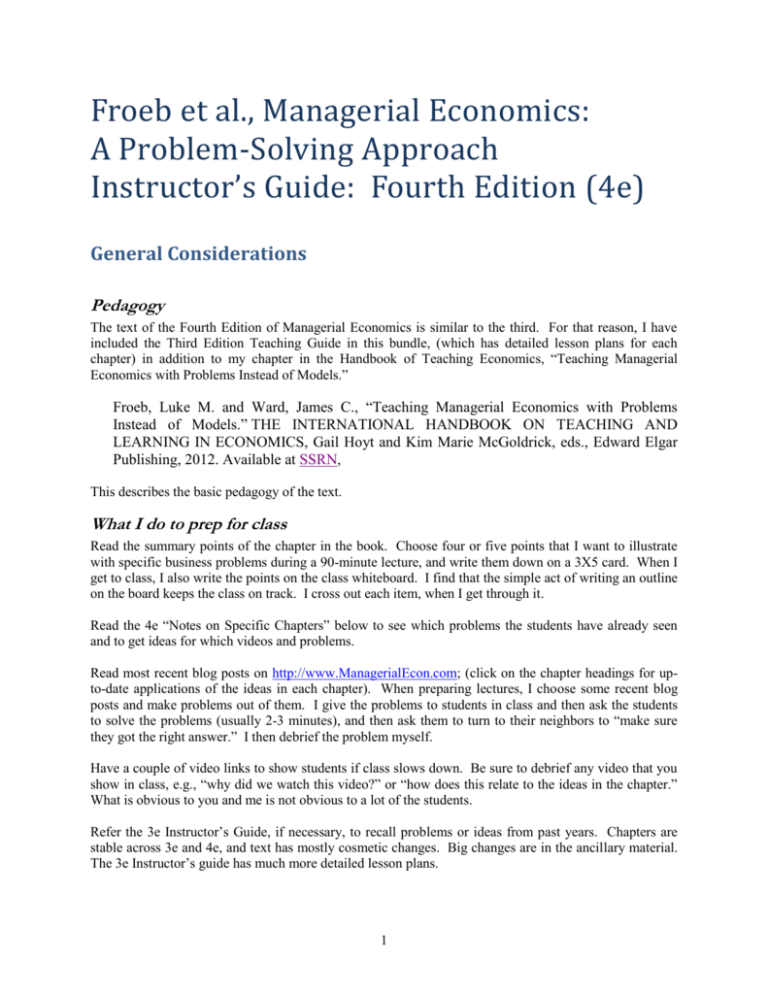
Froeb et al., Managerial Economics:
A Problem-Solving Approach
Instructor’s Guide: Fourth Edition (4e)
General Considerations
Pedagogy
The text of the Fourth Edition of Managerial Economics is similar to the third. For that reason, I have
included the Third Edition Teaching Guide in this bundle, (which has detailed lesson plans for each
chapter) in addition to my chapter in the Handbook of Teaching Economics, “Teaching Managerial
Economics with Problems Instead of Models.”
Froeb, Luke M. and Ward, James C., “Teaching Managerial Economics with Problems
Instead of Models.” THE INTERNATIONAL HANDBOOK ON TEACHING AND
LEARNING IN ECONOMICS, Gail Hoyt and Kim Marie McGoldrick, eds., Edward Elgar
Publishing, 2012. Available at SSRN,
This describes the basic pedagogy of the text.
What I do to prep for class
Read the summary points of the chapter in the book. Choose four or five points that I want to illustrate
with specific business problems during a 90-minute lecture, and write them down on a 3X5 card. When I
get to class, I also write the points on the class whiteboard. I find that the simple act of writing an outline
on the board keeps the class on track. I cross out each item, when I get through it.
Read the 4e “Notes on Specific Chapters” below to see which problems the students have already seen
and to get ideas for which videos and problems.
Read most recent blog posts on http://www.ManagerialEcon.com; (click on the chapter headings for upto-date applications of the ideas in each chapter). When preparing lectures, I choose some recent blog
posts and make problems out of them. I give the problems to students in class and then ask the students
to solve the problems (usually 2-3 minutes), and then ask them to turn to their neighbors to “make sure
they got the right answer.” I then debrief the problem myself.
Have a couple of video links to show students if class slows down. Be sure to debrief any video that you
show in class, e.g., “why did we watch this video?” or “how does this relate to the ideas in the chapter.”
What is obvious to you and me is not obvious to a lot of the students.
Refer the 3e Instructor’s Guide, if necessary, to recall problems or ideas from past years. Chapters are
stable across 3e and 4e, and text has mostly cosmetic changes. Big changes are in the ancillary material.
The 3e Instructor’s guide has much more detailed lesson plans.
1
I don't use slides, but there are two sets of slides available, co-author Mike Wards (University of Texas—
Arlington) and a set based on the book.
Links
Blog posts are at http://www.ManagerialEcon.com; click on the chapter headings for up-to-date
applications of the ideas in each chapter. When preparing lectures, I chose some recent blog posts and
make problems out of them.
Supplementary material (slides, syllabi, practice exams) is available at Cengage.com and at
http://www2.owen.vanderbilt.edu/lukefroeb/textbook/4e
Inverting the classroom
The big difference between the fourth edition (4e) and the third edition (3e)is the amount of ancillary
material available on Coursemate, particularly the Video lectures and interactive quizzes that give
professors the option to “invert the classroom,” i.e., assign lectures as homework and use class time to
solve problems. If you haven’t seen it, watch the Kahn Academy TED Lecture on how the East Palo Alto
School district does this at the High School Level.
If you expect students to watch the videos and do the multiple-choice questions before the class, clearly
communicate this, and design your lectures accordingly. When I do this, I watch the video lecture and
ask questions like “what did you get out of the video lecture?”; “can you think of another solution to the
problem raised in the video?”; or “Is your solution better, why or why not?”
If you don't expect students to read the text or watch the videos, you can use the videos or text as a lesson
plan.
The videos are particularly useful for foreign students with weaker language skills.
MBA Teaching Tips
Be aware that successful teaching comes in many different forms, and that you have to develop a style
that works for you. Here are some tips that I have found useful.
Build the course around the deliverables: Because they are so busy, it is difficult to motivate students
to do work which is not tied to deliverables. So I design the course around the deliverables, and then
figure out what I need to teach in order for students to successfully complete the deliverables.
Put the particular ahead of the general: I begin each topic with a real business puzzle that motivates
the material for the students. Then I get to the general principles, using as-simple-as-I-can make-them
models.
If students are not asking question, they are not engaged: and if they are not engaged, they are not
learning. Sometimes, I will say more and more outrageous things, just to get students to respond. And
once they do, the class always seems to flow better.
Slow down: the most common mistake that I make is to speed up in order to get through the material that
I have on my slides or in my teaching outline for the day. This is folly. Students have enough trouble
absorbing material without you trying to speed through it. Instead, slow down. Students will absorb very
little from fast teaching.
2
Cold call: I find that this keeps students engaged in class (fear?), and I don’t accept “I don’t know” for
an answer. I stand there until the student comes up with an answer, and then turn to the student sitting
next to him, and ask what they think of the previous answer and why. I do make exceptions for foreign
students who have obvious difficulty with the language.
Anticipate lethargy: when I feel that the class has slowed down, I show a video or make students do inclass problems to switch things up. However, if you do an exercise, or show a video, always debrief
it. What seems obvious to you is not to the students.
Never answer a student’s question directly: instead, get another student to answer it.
Never add material to the syllabus: It is OK to remove assignments from the syllabus, but never add, or
shift assignments around.
Notes on specific chapters
These are brief notes that I use to prep myself for class, with links. See the 3e Instructor’s Guide for more
detailed lesson notes.
Chapter 1: What This Book is About
Video Lecture: TVA barges sit at docks for two weeks
4e Textbook: Over-bidding for offshore gas tract
3e Instructor Manual: Sears Auto recommends unnecessary repairs; Kidder Peabody
trader “games” his incentive pay (reproduced below).
2014 in-class stories/problems: Sotheby’s unprofitability; Capitalism & Greed; Surgi-centers
overpaying for new acquisitions; Lincoln Electric movie; showing how piece rate compensation
aligns incentives; Friedman v. Donohue on Greed;
KIDDER-PEABODY (link):
In 1992 Joseph Jett became a star bond trader for Kidder-Peabody, earning a two-million-dollar
bonus. As his monthly profits grew, he was allowed to risk more and more capital in his trading
portfolio, and was eventually promoted to head of the Government Trading Desk. By the end of
1993, Jett had been promoted to managing director. He also received the “Chairman’s Award”
for outstanding performance, in addition to a $9 million year-end bonus.
Joseph Jett traded “strips,” which involved separating the interest payments from the principal on
a government bond. He specialized in putting interest payments back together with the stripped
bonds, thus reconstructing original bond. This activity earns profits by taking advantage of yield
differences between zero-coupon bonds (no interest payments) and interest-bearing bonds.
However, at Kidder-Peabody, this activity seemed to earn profits—even in the absence of any
yield differences. The antiquated information system at Kidder-Peabody tracked zero-coupon
bonds by price instead of yield, which overstated their value once they entered the system. The
information system rewarded Jett contemporaneously for sales of five-day forward contracts on
reconstructed bonds. This allowed Jett to realize contemporaneous profits that would disappear
in five days, when the computer recorded the future reconstruction. However, by rolling the
contracts forward, Jett was able to keep these profits on the books. In order to make this work,
Jett had to continuously increase the size of his portfolio.
3
Early in 1994, the information system at Kidder began having trouble keeping up with Jett’s
trading activity. From 1992-1994, Jett had traded about $1.7 trillion in government securities,
about half of all outstanding government debt. When the source of the profits was uncovered,
Kidder liquidated Jett’s positions, and the company was sold to Paine-Webber for underperforming the market.
Joseph Jett was fired for refusing to cooperate with the resulting internal investigation but was
cleared of criminal fraud charges in 1996. Kidder’s civil suit to collect $9 million from Jett was
rejected by the NASD (National Association of Securities Dealers). He was fined by an SEC
administrative judge but was allowed to keep $3.7 million in compensation earned while at
Kidder.
Jett’s boss, Edward Cerullo, was forced to resign in 1994. The Securities and Exchange
Commission charged him with failing to supervise Jett’s trading activities. He was suspended
from working in the industry for one year, but walked away with $9 million in severance pay and
deferred compensation.
Chapter 2: The One Lesson of Business
Video Lecture: House buying moves assets to higher valued uses; Regulation Q is a
price control and Euro dollars were invented to circumvent the control.
4e Textbook: Regulation Q and Euro dollars; Viaticals move life insurance to a higher
valued buyer; RentStuff.com consummates voluntary transactions; Insurance
moves risk to higher valued uses; Video game “gold farmers” move “gold” to
higher valued uses; Mervyns department store breakup moves real estate to
higher valued use; Kidney sales move kidneys to higher valued use; Sweden
turnover tax killed its stock market, and moved transactions to London; First time
homebuyers subsidy moves houses to lower value buyers; Uber succeeds by
taking advantage of inefficiencies created by taxi regulation.
3e Instructor Manual: Zimbabwe deters transactions.
2014 in-class stories/problems: Monkey Parking; McDonalds in Italy; US Safety Net has
Become Hammock; Stossel, Greedy Seniors; Stossel, Sweatshops; Stossel,
Flood Insurance; Stossel, On Vanderbilt’s Greed; Larry the Liquidator’s Speech;
Book Review: Ethics and Public Policy; What’s going on in the EU?
Chapter 3: Benefits, Costs, and Decisions
Video Lecture: Cadbury Bombay Flats & EVA; Football game sunk and hidden costs;
GE outsourcing Washing machine agitator [This is a rich problem, and I redo it in
class. I focus first on the question of outsourcing and its lesson to ignore sunk
costs. Then I shift focus to the problem created by allowing managers to ignore
sunk costs after they are incurred. If we allow the current plant manager to walk
away from the sunk costs, does that mean he will over-invest, because he is not
bearing the full costs of his (potentially bad) investment decisions.]; Does EVA
work?
4e Textbook: TVA 8400 vs. 8800 coal; Cadbury Bombay Flats & EVA; Football game
sunk and hidden costs; GE outsourcing Washing machine agitator; Long beach
4
financial hidden cost of bad loans; What happens when you are penalized for
doing the right thing?
3e Instructor Manual: Coca-Cola and EVA; My mom and moving to old folks home.
2014 in-class stories/problems: Standup Economist on Mankiw; How did Oracle Win the
Cup; Pepsi and EVA.; Is organic food good for the environment?; Is Anger
Rational?; Sunk cost Fallacy in Real Estate; Reluctance of Businesses to Pull the
Plug
Chapter 4: Extent (how much) Decisions
Video Lecture: Loggers royalty vs. fixed fee; Memorial Obstetrics deliveries; TV vs.
Direct mail customer acquisition cost; sales commissions; COO incentive pay of
PR firm.
4e Textbook: Loans during financial crisis; Memorial Obstetrics deliveries; TV vs. Direct
mail customer acquisition cost; sales commissions; COO incentive pay of PR
3e Instructor Manual: Truck leasing company; Amex Platinum Credit cards;
2014 in-class stories/problems: Getting Auto Mechanics to work Harder; CBO on
Incentive effects of ACA and Min Wage; Bunching and High Powered
Commissions; Monkeys react to incentive pay; EMR’s boost medical bills; Do
environmentalists cause pollution?
Chapter 5: Investment Decisions: Look Ahead and Reason Back
Video Lecture: Buying an apartment building in 2007; discounting; NPV; break-even
analysis of Nissan truck redesign; shutdown analysis; national geographic holds
up its printer; contractual view of marriage.
4e Textbook: Nashville pensions; break-even analysis of Nissan Truck redesign; TVA
holds up holds up Mobil; National Geographic holds up printer; Bauxite mines
and alumina refiners; marriage as a solution to post-contractual hold-up.
3e Instructor Manual: GM holding up wire harness supplier; Unocal holds up CARB;
2014 in-class stories/problems: Unocal holds up California; Europe’s Troubles are
microeconomic; Underfunded pensions exposed by new accounting rules; Health
is an investment: new thinking on AIDS in Africa; Signs of Intelligent Life in
Nashville; What can Nashville learn from Detroit’s Troubles?
Chapter 6: Simple Pricing
Video Lecture: Snickers in Russia; Whole Foods; [error in video computing (P-MC)P]
4e Textbook: Mattel’s hot wheels; Marginal analysis of pricing (your boss commits a
pricing fallacy; Gas tax in DC; Elasticity; Mid-South Grocery; Nike running shoes;
HFCS vs. Sugar; ATM pricing in Indiana; iPhones; NY Times in Nashville;
3e Instructor Manual:
Cheaper iPhones are being introduced by Apple:
Citing a firm survey of consumers, Morgan Stanley analyst Kathryn Huberty said that a
$50 price cut (25%) could increase demand by 50 per cent and a $100 cut by 100 per
cent. This implies an elasticity of demand for iPhones of -2. The cut will increases profit
if the margin, (P-MC)/P, greater than 50%.
Economics in the Whole Foods merger case
5
At this point I like to go to the Whole Foods merger case and describe that the FTC
wanted to define a PNOS product market (Premium Natural and Organic Supermarket)
and their evidence was statements by John Mackay that acquiring Wild Oats would
remove the last viable competitor and evidence that when Wild Oats shut down in
Boulder Colorado, most of its customers went to Whole Foods.
On the other side of the case, Economist David Scheffman used a marginal analysis of
the PNOS market, saying essentially that the P-MC/P > 1/|e| where the margin was 40%
and he argued qualitatively that since consumers who shop at Whole Foods also shop at
other grocery stores it was likely that that demand elasticity was bigger than -2. Below
we explain that he used what is known as “critical loss” analysis. Instead of asking
whether it would be profitable for all the stores in the PNOS segment to raise price, he
instead argued that a 5% price increase would be unprofitable because the firm would
lose more than the “critical” or “break even” quantity of 11.1%. The judge, who shopped
at both Safeway and Whole Foods agreed with Professor Scheffman, and allowed the
merger to go through, reasoning that the actual loss (i.e., elastic demand) would be bigger
than 11.1%.
2014 in-class stories/problems: Why are Turkey prices lower when demand is higher?; If
Walter White had hired a market consultant; Parking meters and yield
management; Price & R&D; Switching Cost and Competition; Is NY Parks dept.
maximizing profit? Should we raise the minimum wage?
Chapter 7: Economies of Scale
Video Lecture: Airplane learning curves; Economies of scale in US Premium Beer;
Restaurants economies of scope between lunch and dinner.
4e Textbook: Rayovac; Big Box Retailers (Staples, Office Depot); US Poultry; Gibson
Guitar; Jimmy Dean’s Sausage; Mars Pet Food Extruder Lines; Sony and Akiro
Morita.
3e Instructor Manual: Company X: bottleneck in testing equipment.
2014 in-class stories/problems: Nestle (link) and derive formula Profit=Q(P-AC) to
motivate why suppliers give them lower prices; Nissan-Renault (link); Avis-Zip
(link); Pepsi-Gatorade (synergies on distribution and demand side, as Pepsi
could now market its portfolio of drinks to smaller retail channels that had room
for only Pepsi or Coke products but not both); Sears attempt to diversify into
financial products (do you want stock advice from the store where you buy your
socket wrenches); and 1990’s banks attempts to add insurance which they could
sell to their captive customers.
Chapter 8: Market and Industry Changes
Video Lecture: Cash for Clunkers; Housing Market;
4e Textbook: Portable Electric Generators and Y2K.
3e Instructor Manual: Tuscon pipeline break; in-class experiments with deck of cards (deal out a
deck, red cards denote seller costs, black cards buyer values. Let students transact and
record transaction prices. Plot the demand and supply cuves and see how close they
are.
2014 in-class stories/problems: D={$7,$6,$4,…,$1} [values] and S={$1,$2,$3,…,$7} [costs],
compute equilibrium. Then re-compute equilibrium where S=S+$2 [tax]; and D=D+$2
6
[subsidy]; prie floors [minimum wage]; price ceilings [kidney sales]; Keynesian wage
stickiness explains unemployment; Supply/Demand for prediction, what I call “Forward”
analysis (examples, ask students to forecast effects of new EPA diesel regulations (link)
to predict changes in price and quantity from 2006, 2007, 2008); Quantitative Easing
(increase in supply of loans); Also Backward analysis, use demand/supply to explain
existing price and quantity changes, like UK drop in wages and increase in employment
(link); the negative correlation between Spam and Steak(demand variation); smart
phone prices dropping (increase in supply)
Chapter 9: Long-run Equilibrium
Video Lecture: 2008 low risk premia on risky assets; truck driving vs. teaching; San Diego vs.
Nashville; Risky vs. less risky assets; Flashdance: legwarmers.
4e Textbook: Good to Great book; Compensating wage differentials; San Diego vs. Nashville;
3e Instructor Manual: compensating risk differentials; flashdance; Apple Macintosh (Jobs’s
biggest mistake vs. MSFT DOS (Gates’ biggest success).
2014 in-class stories/problems: Indifference principle: why are accounting professors paid
more than econ professors; Risk Premia: Risk-on, risk-off trading; Don Marron’s best
chart of the year.
Chapter 10: Strategy: the Quest to Slow Profit Erosion
Video Lecture: Oakland A’s. Porter’s 5 forces: airlines.
4e Textbook: Starbuck’s, Pharmaceutical’s; Perdue Chicken;
3e Instructor Manual: MBA programs; Netflix;
2014 in-class stories/problems: Business school strategy; Southwest; The Force that Porter
Forgot; How to tell if your resources gives you a competitive advantage;
Chapter 11: Demand/Supply Analysis of Trade, Bubbles, and Market-Making
Video Lecture: 1. How is FX determined (2010 QE’s affect on FX; “carry trade”). 2. How do
changes in FX affect trade? (effect of 1. On consumers in US and Europe, and in US).
3. How are bubbles determined? (house prices) ;.
4e Textbook: Nissan Rogue margins affected by exchange rates; Greece (fixed exchange rate)
vs. Iceland (flexible exchange rate); Effects of Peso devaluation on Mexico vs. US golf
courses; US real estate bubble, and Shiller’s comparison of buying to owning; Shiller’s
P/E ratio.
3e Instructor Manual: Effects of Peso devaluation on twin border cities of El Paso vs. Juarez
(demand can shift across the border, but supply is stationary, so a devaluation affects
demand but not supply).
2014 in-class stories/problems: Euro Weakens as ECB reduces interest rates;
Chapter 12: More Realistic and Complex Pricing
Video Lecture: teaser: seasonal price dips for frozen pies: pumpkin pie vs. carrot cake. 1.
Commonly owned products (Labatts Budweiser in upstate NY). 2. Yield Mgt (parking lot:
how many parking spaces to build, how many parking spaces to sell, once built; 3. cruise
lines and error cost priing; Advertising vs. promotion elasticity price).
7
4e Textbook: Harry Potter pricing by Amazon; 2009 AB/Imbev merger and Labatt’s divestiture
by Imbev; common ownership of a grocery store and a parking lot increases MR at
each;
3e Instructor Manual: Blockbuster/Hollywood video merger challenged by FTC (Froeb was chief
economist at FTC when this was challenged); GE/Hughest; MSFT/Quicken; Parking lot
merger (Rev Mgt implies no merger effect, see “antitrust motivation” section in Froeb
Paper); promotional pricing in ice cream (see froeb paper); Turkey on Thanksgiving;
2014 in-class stories/problems: Euro Weakens as ECB reduces interest rates; Surprise Fed
announcement causes dollar to weaken.
Chapter 13: Direct Price Discrimination
Video Lecture: Discrimination at an archaeological site in India; numerical example
using aggregate demand from ten consumers with values D={$10, $9, …, $1};
movie theatre discrimination against younger consumers; “grey markets” in drugs
between US and Mexico; Airlines: business vs. leisure travellers; Business
schools use financial aid to discriminate against weaker students; Entry reduces
ability of firms to discriminate in airlines.
4e Textbook: Pricing Dell laptops for small businesses, large businesses, consumers;
Pricing museum entry for locals vs. tourists; only schmucks pay retail.
3e Instructor Manual: See chapter 14 notes below.
2014 in-class stories/problems: Should you travel to India for your Hepatitis-C cure?;
In-class problem: MC=$2.50; D1={11,10,9,8,7,6,5}; D2={7,6,5,4,3,2,1}; Compute
prices and profit from discrimination and compare to uniform pricing. Answer is
that p1=$7, p2=$5, Uniform price=$6. Debrief with stories about drug
discrimination between US and Canada (US is about 6X larger than Canada so
result of drug re-importation would be and US and Africa. In class quiz: In
general, countries pay prices for drugs in proportion to their income. However
there is one country that pays more? Which one is it? ANSWER: Mexico,
because so many people go down there and buy drugs and bring them back
(grey market).
Chapter 14: Indirect Price Discrimination
Video Lecture: coupon clipping; disabled versions of the same software;.
4e Textbook: Pricing Dell laptops for small businesses, large businesses, consumers;
Pricing museum entry for locals vs. tourists; only schmucks pay retail.
3e Instructor Manual: Medical devices priced in Northern vs. Southern Europe; Gray
market for iPhones; high priced wine sold at lower margins than low priced wine;
individual demand for t shirts: volume discounts, bundling, two-part pricing.
2014 in-class stories/problems: Bundling Architecture and Art: Blog post showing how
pure bundling can make consumers appear more homogeneous which allows the
bundler to extract consumer surplus with a single price; GovX makes money by
offering discounts to military and first responders.
Chapter 15: Game Theory
Video Lecture: Golden Balls I; Golden Balls II; Prisoners’ dilemma; pricing dilemma;
repeated pricing dilemma; strategy to reduce rivalry
8
4e Textbook: pricing dilemma between two department stores on Bermuda; entry
deterrence game; prisoners’ dilemma; game of chicken; dating game;
shirking/monitoring game.
3e Instructor Manual: American Airlines pricing dilemma; Chinese banks pricing
dilemma;
Mike Shor, GameTheory.net
Simultaneous game self test
http://www2.owen.vanderbilt.edu/mike.shor/Courses/game-theory/quiz/quiz1.html
Sequential game self test
http://www2.owen.vanderbilt.edu/mike.shor/Courses/game-theory/quiz/quiz4.html
Play the repeated prisoners' dilemma
http://www.gametheory.net/Mike/applets/PDilemma/
2014 in-class stories/problems: John McMillan’s Rational Pigs Puzzle; Prisoners’
dilemma: TN Hospitals as Governor “Tax us Please”; Repeated PD and
Strategy;
Chapter 16: Bargaining
Video Lecture: Strategic view of bargaining: Game of Chicken; Game of Bargaining;
Committing to a take-it-or-leave-it position; Axiomatic or nonstrategic view of
bargaining. Tina and Becky quit their jobs to start restaurant.
4e Textbook: NBA vs. players union; politicians against labor unions; hospitals and drug
stores vs. drug companies; labor/management game of chicken; nonstrategic
view; MCO vs. two hospitals who merge and bargain together.
e
3 Instructor Manual: Toyota Dealers in Kenosha; CHAOS at Midwest Express
2014 in-class stories/problems: Dating Game (blog post); sequential solution; non
strategic view; How best to sell drugs;
Chapter 17: Making Decisions with Uncertainty
Video Lecture: Teleswitch; real estate investment prospectus.
4e Textbook: XYZ software company; entry with uncertainty; uncertainty in pricing;
minimizing expected error costs; Risk vs. Uncertainty.
3e Instructor Manual: Teleswitch; Residential real estate deal; Global Warming and type
I and type II errors; Pricing with uncertainty;
2014 in-class stories/problems: DG vs FT acquiring FD (higher takeover premium
reflects higher antitrust risk); Video, Esther Duflo’s TED Talk on using
experiments to evaluate social policy (ask students why their companies don't
run experiments. ANSWER: because if they discover a policy didn’t work,
whoever thought of the policy could be identified as a bad decision maker).
Chapter 18: Auctions
https://www.youtube.com/watch?v=-Fbtr7WrikE&feature=youtu.be
9
Video Lecture: Delta auctions for seats; oral auctions; selling vs. procurement auctions;
posted price vs. auctions; more biddershigher prices; second price, sealed bid
auctions; 17th century auctions; stamp dealers auctions; winners’ curse.
4e Textbook: auctioning Nortel patents; oral, second price, first price, bid rigging;
common value.
3e Instructor Manual: Vickrey auctions are equivalent to English auctions. Derive
expected auction outcome with 2 bidders and a binomial distribution; then with 3
bidders. Auction off a jar of coins to illustrate winners’ curse, a type of adverse
selection.
2014 in-class stories/problems: Economists and dating auctions; Auctions for parking
spaces; Advice for selling on eBay; Hospital auctions;
Chapter 19: Adverse Selection
Video Lecture: New Orleans: “Mister I bet I can tell where you got them shoes”; Bike
insurance; market for “lemons” (cars); car leasing as a solution to adverse
selection (blog post).
4e Textbook: Zappos; Used Car leasing (lemons); Louisiana covenant marriages; car
insurance, education as a signal or screen; Internet sales;
3e Instructor Manual: Health insurance, car insurance, job screening; why the Rolling
Stones sell out.
2014 in-class stories/problems: Why doesn’t homeowners insurance cover floods,
earthquakes or bed bugs; REPOST: Lincoln Electric succeeds by organizing as a
sweat shop; How do insurers identify good drivers?
Chapter 20: The Problem of Moral Hazard
Video Lecture: why do we fire workers instead of lowering their pay during downturns;
bike insurance (blog post); change in liability laws reduces plane crashes (blog
post); why do women physicians get c-sections at 1/12 the rate of non physicians
(blog post).
4e Textbook: FCC financing of spectrum auctions; Progressive Insurance; Bike
insurance; Anti-lock Braking Systems; Shirking as moral hazard; moral hazard in
lending; moral hazard and 2008 financial crisis;
e
3 Instructor Manual: insurance; lending; shirking; Why do volvo’s stop LESS frequently
at stop signs (ANSWER: Adverse selection, bad drivers buy Volvo’s; Moral
Hazard, once I buy a Volvo, the cost of running a stop sign goes down).
2014 in-class stories/problems: What is causing inequality?; Some Cops Don't Like
Being Monitored; Beware the Cobra Effect; Why doesn't insurance cover floods,
earthquakes or bed bugs?;
Chapter 21: Getting Employees to Work in the Firm’s Best Interest
Video Lecture: why do women physicians get c-sections at 1/12 the rate of non
physicians (blog post); capitation rates vs. fee-for-service (blog post); franchisorfranchisee realtionships: fixed fee, profit sharing,
10
4e Textbook: Sotheby’s conflict with art experts. Principal-Agent relationships.
Principles for controlling. Marketing (MR>MC) vs. Sales (MR>0). Franchising.
Framework.
e
3 Instructor Manual: Sotheby’s; Landowner-tenant farmer principal agent; McDonaldsFranchisees on freeways vs. in towns;
2014 in-class stories/problems: How best to sell drugs; How do oil investors (principals)
align the incentives of operators (agents) with their profitability goals?; Should
Tennessee fund venture capital?; REPOST: why are so many donated kidneys
discarded?
Chapter 22: Getting Divisions to Work in the Best Interests of the Firm
Video Lecture: Interdivision conflict between toner and cartridge divisions. Personifying
divisions by imagining the division responds to its performance metric: profit
centers; cost centers; investment centers; revenue centers. Corporate
budgeting: paying people to lie.
4e Textbook: Black liquor soap. Personifying divisions by imagining the division
responds to its performance metric: profit centers; cost centers; investment
centers; revenue centers. Incentive confict arises from different concerns.
Transfer pricing: paper vs. cardboard box divisions. Functional Silos vs.
Process teams: Jet design; and bank loan origination vs. loan servicing. Budget
Games, paying people to lie.
3e Instructor Manual: one principal, multiple agents applied to corporate relationships;
functional silos vs. process teams; corporate budgeting: paying people to lie;
transfer pricing;
2014 in-class stories/problems: Be careful of silos; Transfer Pricing Failure in Academia;
Which organizational forms can best adapt to change?; Can functionally
organized banks see risk?
Chapter 23: Managing Vertical Relationships
Video Lecture: wedding dresses and exclusive dealing; coke vs. its retail outlets buying
a refrigerator. Double marginalization: 2-part pricing vs. vertical integration vs.
RPM. 5 principles: 1. anticipate self interested behavior; 2. Recognize that there
are a variety of solutions; 3. Some solutions increase antitrust risk. 4. If you
choose a solution that increases antitrust risk, make sure that it has a sound
business justification. 5. Beware of vertical integration as a solution as it creates
other incentive conflicts.
4e Textbook: Argent Tobacco vs. retailers: incentive conflict over pass-thru of
wholesale to retail price. Manufacturers vs. retailers incentive conflict over
quality, price, promotion, free riding, new product introduction, arbitrage to
prevent price discrimination. Tax Avoidance. Antitrust Risk: Coke vs. retailers;
3M vs. retailers. Vertical mergers require synergies: AT&T aq of TCI.
3e Instructor Manual: regulatory evasion; Manufacturer-retailer conflicts: pricing conflict,
investment conflict, advertising conflict, price discrimination conflict.
11
2014 in-class stories/problems: Required/Prohibited Vertical Integration; REPOST: Will
resale price maintenance return?; Vertical not-quite-integration in medical care;
Shirking at Hotels; Double Marginalization in the Movie Industry
12


